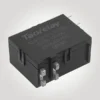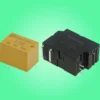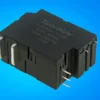
1. Electromagnetic Relay (EMR)
Features:
- Uses an electromagnetic coil to mechanically switch contacts
- Simple structure, reliable operation
- Available in various configurations (SPST, SPDT, DPDT)
Applications:
- General-purpose control in industrial automation
- Household appliances (washing machines, microwave ovens)
- Low-frequency signal switching
2. Solid State Relay (SSR)
Features:
- No moving parts; switches electronically
- Fast response time
- High durability and long life
- No contact bounce, silent operation
Applications:
- High-speed switching in automation systems
- Temperature control in industrial heating equipment
- Sensitive or high-reliability electronics (e.g., medical devices)
3. Magnetic Latching Relay (Bistable Relay)
Features:
- Maintains contact position without continuous power
- Coil is only energized momentarily during switching
- Low power consumption
- Vibration-resistant
Applications:
- Smart meters (electricity, gas, water)
- Power distribution and remote control systems
- Energy-saving applications in IoT devices
4. Reed Relay
Features:
- Contacts are enclosed in a glass tube
- Fast switching speed
- Compact size
- Suitable for low-current applications
Applications:
- Test and measurement equipment
- Telecommunication systems
- Intrinsically safe circuits (explosion-proof environments)
5. Time Delay Relay
Features:
- Introduces a delay in switching on/off
- Adjustable time settings
- Can be analog or digital
Applications:
- Motor start/stop sequencing
- Lighting control systems
- Elevator and automation safety timing
6. Thermal Relay
Features:
- Operates based on heat generated by current flow
- Provides overload protection
- Resettable manually or automatically
Applications:
- Motor protection circuits
- HVAC systems
- Industrial automation
7. High Voltage Relay
Features:
- Designed for switching high-voltage circuits (up to kV levels)
- Excellent insulation performance
- Arc suppression and safety design
Applications:
- New energy vehicles (EVs)
- Photovoltaic systems (PV)
- Charging stations and high-voltage power equipment
8. Power Relay
Features:
- Capable of switching high current loads
- Robust construction for heavy-duty cycles
- Available in different voltage/current ratings
Applications:
- Home appliances (air conditioners, refrigerators)
- Industrial control panels
- Power management systems
9. Automotive Relay
Features:
- Designed for 12V or 24V DC automotive systems
- Vibration and temperature resistant
- Compact and rugged
Applications:
- Vehicle lighting, ignition, fuel pump control
- Electric window and seat control systems
- Battery management units (BMUs)
10. Signal Relay
Features:
- Low contact capacity, high sensitivity
- Suitable for signal transmission
- Low noise and distortion
Applications:
- Communication systems
- Audio and video switching equipment
- Data acquisition systems
11. Polarized Relay
Features:
- Operates based on magnetic polarity
- Fast and precise switching
- Suitable for low-power signals
Applications:
- Telecommunications
- Railway signaling systems
- Remote control and automation
12. Overload Relay
Features:
- Protects motors from excessive current
- Often combined with contactors
- Can be thermal or electronic
Applications:
- Motor control centers (MCCs)
- Conveyor systems
- Pump stations
13. Relay Module (Integrated Relay Board)
Features:
- Multiple relays integrated on a PCB
- Easy installation with control interface
- Often used with microcontrollers
Applications:
- Home automation projects
- DIY electronics (Arduino, Raspberry Pi)
- Prototyping and development systems
Relays are essential components in electrical and electronic systems, serving as automatic switches that control circuits with precision, safety, and efficiency. From traditional electromagnetic relays to modern solid-state and latching types, each relay offers unique features tailored to specific needs—whether it’s fast switching, energy saving, high voltage isolation, or signal integrity. Their wide-ranging applications span across industrial automation, smart grids, home appliances, electric vehicles, and communication systems. Understanding the characteristics and usage scenarios of each relay type is crucial for selecting the right solution in today’s increasingly intelligent and energy-conscious world.




